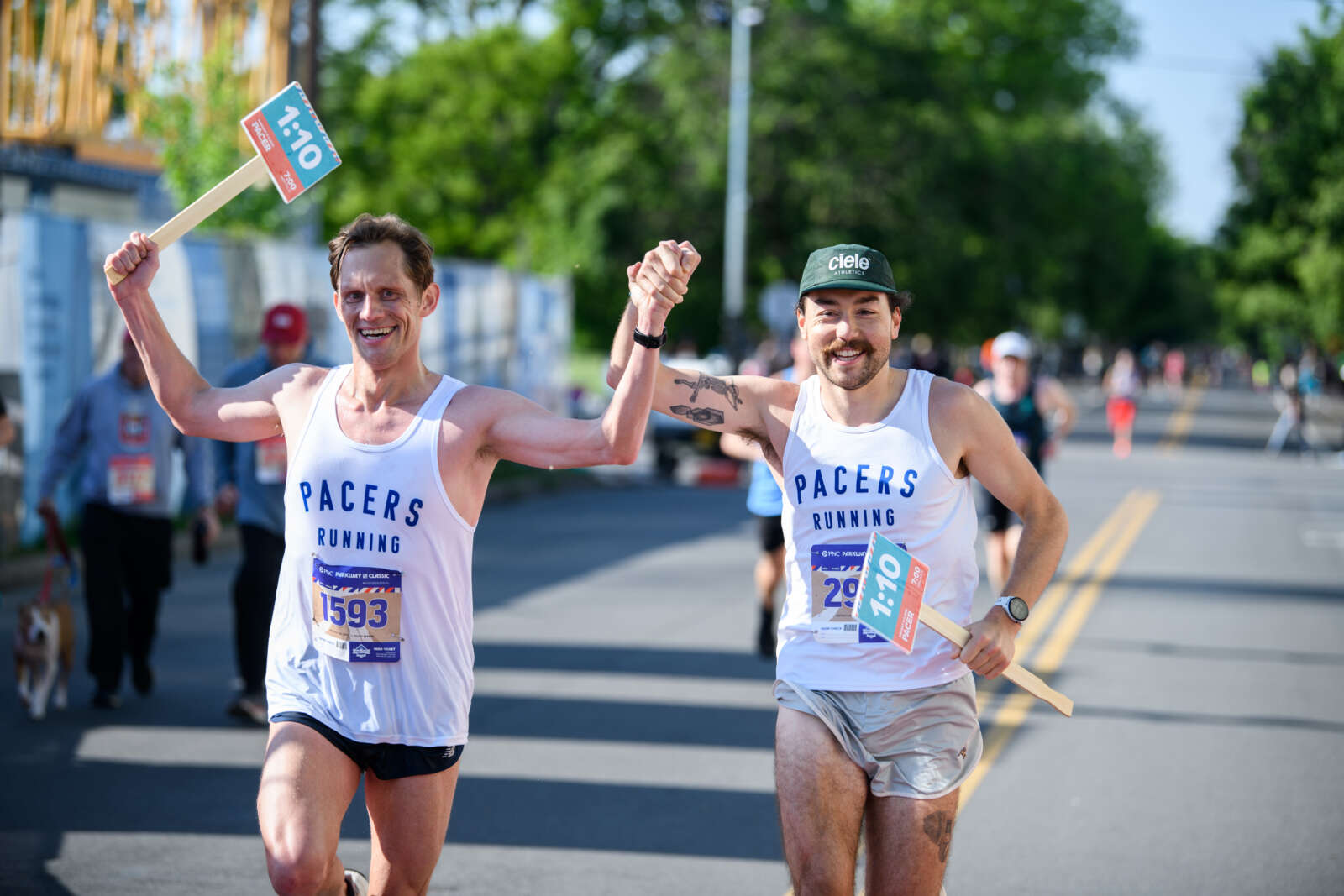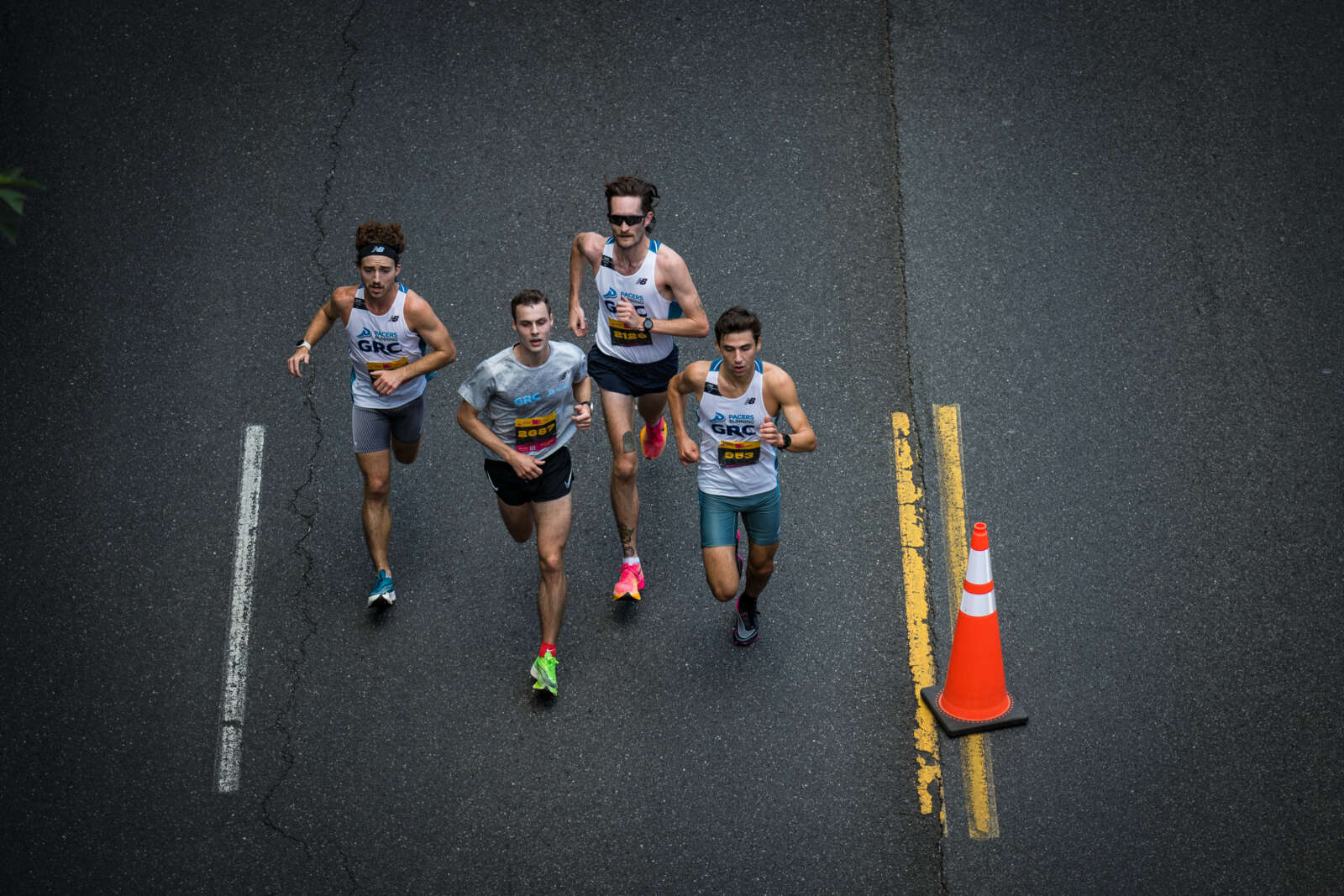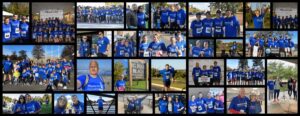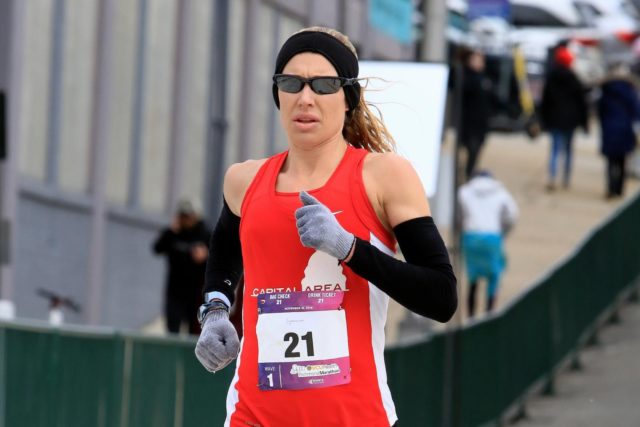
Running is typically a choice for Susanna Sullivan. It’s been her sport since she was at George Mason High School and her hobby even longer.
But as the October sunset started to overtake her in Maine’s Acadia National Park, the darkness forced her close to her race pace, or else she was going to be in trouble. She had finished up a hard run on the hilly dirt roads she is so fond of and stopped to report back to her coach, George Buckheit.
“I was in a national park by myself and it was getting pitch-black,” she said. “I was planning to walk back to my car when I was done, but I just had to run harder than I had for the workout.”
Light was fading fast, but by the time she was safely back to the car, she welcomed back a sensation she hadn’t felt in years. And she certainly hadn’t felt it in the six weeks she had been running on land consistently.
“I felt amazing,” she said. “For the first time I felt like I was really on the right track.”
That came just in time, because about two weeks later, Sullivan, 29, was due to race the Richmond Marathon, just as the 2020 Olympic Marathon Trials qualifying window started to close. That wasn’t to say she couldn’t try a later race, but as the 20th finisher from the 2016 trials and one of the D.C. area’s best distance runners over the last six years, she didn’t want to just make it to Atlanta at the last minute, she wanted to make the trip worth it.
Despite finishing a personal-worst 2:43:31, she got what she needed – a three-month extension, by virtue of breaking 2:45, to try to get back to the kind of fitness that could put her in the mix of long-shot amateurs at the trials.
“It would be a lot to ask, but I don’t think it’s unreasonable to think I’d be in PR shape in three months,” she said, two days after passing that three-month mark. “Will I be the fittest I’ve ever been when I show up in Atlanta? Probably not, but I also have the experience in having done one (marathon trials race) before.”
Her PR remains 2:35:39 from her first marathon – Grandma’s in 2015. It was a race that Buckheit, who has been working with Sullivan, since she joined Capital Area Runners in 2012, said she executed perfectly.
“Looking at that 2015 season, the marathon was an afterthought,” he said, pointing to a long series of successful road and track races that led her to taking a flyer on Grandma’s. “She did a couple of 20-mile runs and ran a smart race and did exactly what she needed to do. She didn’t spend too much time thinking about it, but she also had no idea what she was getting into. Sometimes ignorance is bliss.”
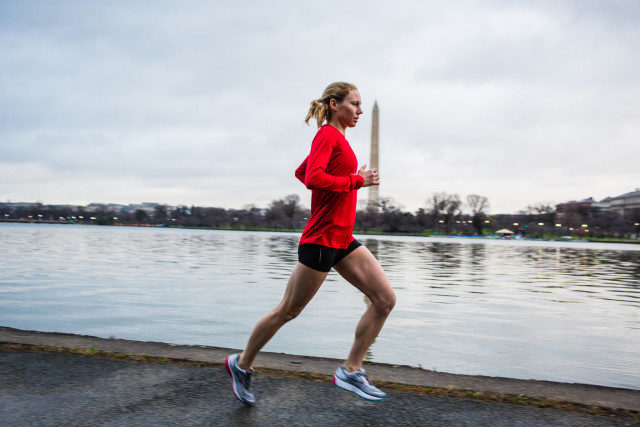
Sullivan, now living in Reston, hadn’t spent the last few years with much confidence in her running. Whether it was the result of being rear ended on her drive to work nearly two years before the 2019 Richmond race or ill-executed training, like her Capital Area Runners teammate Jillian Pollack, she was spending a lot more time in the pool, trying to maintain her fitness instead of advancing it.
She’d emerge for short stints on land, including a disappointing race at the 2018 Credit Union Cherry Blossom Ten Mile Run, but invariably would be back in the pool before too long.
“The biggest blessing was that at no point did the pool hurt,” she said. “That was a clue I was going to be okay – the movement pattern was okay.”
“I never felt like I was more than three weeks from not having any pain. That hope kept me working hard in the pool. If I knew when I started this that I’d be in the pool most of the time for two years, I’d have broken down and cried.”
Not that that strategy wouldn’t work.
She did a few rounds with specialists before she convinced an orthopedist to order an MRI.
Her winning argument? Tears.
The diagnosis? Tears – in her hamstrings. And an impinged obturator nerve in her hip and thigh.
“It was very informative once we had the MRI,” Sullivan said. “(The orthopedist) thought I had problems with my piriformis, and I might have at some point, but that wasn’t it in the end.”
Buckheit has another theory.
“I think a lot of the issues she had were from overtraining,” he said. “She fell back into her habits from Notre Dame (where she spent most of her time injured), hammering daily runs and then working out.
“She had a taste of success (at Grandma’s and the 2016 Trials) and wanted more, but lost sight of what got her to that success. Shame on me for not recognizing it earlier.”
A physical therapist referral from stretching guru Peter Sherry set Sullivan up with someone she trusted.
“She was the one medical professional who was relentless in figuring this out,” Sullivan said. “Luckily, that only took a little more than an hour.”
Sullivan was lacking much of the hip stability she once took for granted. The contrast between the two when they did exercises on stability balls embarrassed Sullivan, even more so because her PT was due for a hip replacement.
“What was apparent to me was that if she could do these exercises with a bad hip, and I’m quietly horrified, I have a long way to go.”
This was a few days after she had decided against racing Grandma’s Marathon.
“I was delusional,” she said of the decision to sign up for the mid-June marathon. “I might have been able to do it, but it wouldn’t have been sustainable.”
Fortunately, they met as the school year was winding down, and Sullivan would have a few months without spending her days teaching math and science to fifth graders at Haycock Elementary School in Falls Church.
“I had the whole summer to focus on getting myself back,” she said. She put some of her extra energy into playing the piano after taking time off, and adopting a cat, Neptune, who had helped her relax (once he stopped yowling at night).
Sullivan kept up a torrid cross training pace. She accompanied her teammates to Camp CAR in Bar Harbor, and combining running, water running (at a conversion of 10 minutes per mile) and biking (five miles equalling one mile of running) totaled 130 miles.
“Going to Acadia is magical,” she said. “I wasn’t going to go up there and just go for walks.”
Finally, in September, she felt ready to make a push for a trials qualifier.
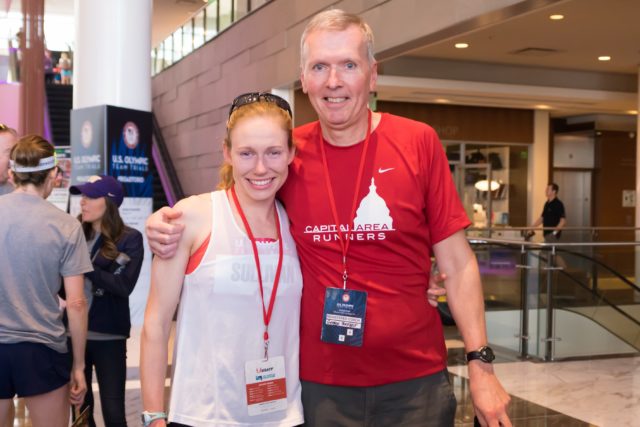
“She has the talent to run 2:45 most days, and she has always been doing the aerobic work, so it wasn’t like she was starting from scratch,” Buckheit said. “What you’ve seen recently is a combination of her feeling better and I stopped fighting the way she’s been running.”
Buckheit knew the key to getting Sullivan to Richmond in one piece meant adjusting to her tendencies to push harder on easy days than he wanted, so they would sacrifice her interval work.
“We tried a few, but I pulled her off before too long,” Buckheit said. “The only time I wanted her on the track was for tempo stuff. She could get by to 2:45 without turnover work. I should have encouraged her to do that sooner.”
One of those tempos was four miles, with assistance from Philippe Rolly.
“I finished and George said I was ready to run 2:45,” Sullivan said. “I don’t know where he got that from four miles on the track.”
It wasn’t the pace or the distance she ran, but the way she ran it.
“She looked like the old Susanna,” Buckheit said of that workout. “To watch the way she was running, she didn’t look tentative, she looked smooth again, she didn’t look herky jerky. I wondered where the hell she had been the last three years.”
She weathered a psychological storm when a course change to her only race leading up to Richmond, the Reston Pumpkin 5k, ended up with a long course and a temporarily deflated confidence when Sullivan failed to break 19 minutes before the consensus among GPS wearers was the that course was at least .4 miles long.
Sullivan kept picking up positive signs. What was supposed to be a 21 mile run in the pouring rain Oct. 20 ended up being at least a mile too long, but the fatigue that hit her toward the end was what she was used to feeling at mile 16 of long runs in previous marathon buildups.
The solo run in Acadia, part of a long weekend, was a big step. As was a simple distance run 10 days before Richmond.
“Everything felt fluid for the first time in two years,” she said. “I knew I could do it. The whole week before, I was very Zen about it. I knew it was going to hurt, but I also knew I could do it.”
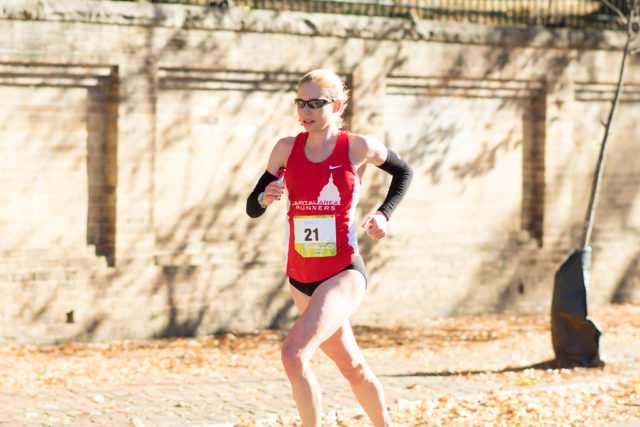
Richmond appealed to Sullivan for several reasons. It was close enough to be easy to reach the race, and many of her Capital Area Runners teammates would be in town, racing or cheering.
She knew the course, having finished second in the 2016 marathon, and the atmosphere was more to her liking. Plus, if she opted for the California International Marathon in early December, or even the Houston Marathon in January, she would have less time to properly train for the Feb. 29 trials.
“You have the pace groups and the water bottles at CIM, so that makes things easier, but you also have all of the hype about who was going for the trials standard,” Sullivan said. “With everything that had gone on the last two years, I wanted to make this as emotionally easy on myself as I could without added pressure.”
Sullivan and Buckheit clashed on her race strategy. He wanted her to negative split the race, but she saw strong winds forecast for the second hour of the race and wanted to bank time.
“What I don’t want to happen is to try to run a pace I haven’t run in two years into a headwind when the Olympic Trials are on the line,” she said. “Whether it’s physically possible is irrelevant; I don’t want this to be the most miserable emotional experience.”
She came through the half in 1:19:24.
“That’s exactly what I didn’t want her to do,” Buckheit said. “She was out in the lead in the first mile.”
Sure enough, when she hit the Lee Bridge at mile 16, things got ugly.
“The flags were blown straight out and I felt like I wasn’t moving,” Sullivan said. “George told me not to fight it too much, and for a while I felt like I had to just not get blown back … I realized unless I ran eight minutes, I wasn’t going to destroy the time I had banked.”
She covered that mile in 6:35, though it took her a few miles to recover from the effort and the resistance.
By mile 19, her quads were hurting, but she came through 20 miles in 2:03:35, good for 6:10 pace. And before then, a thought came to her that put her physical challenges in perspective.
“I realized I had a little over an hour to run, and thought about the times months ago when the idea of a pain-free hour of running seemed so far away,” she said. “I could keep pushing.”
With a mile left, Buckheit let her know she just had to run 7:50 to make it, and the generous downhill at the end of the Richmond course helped her avoid even coming close to that.
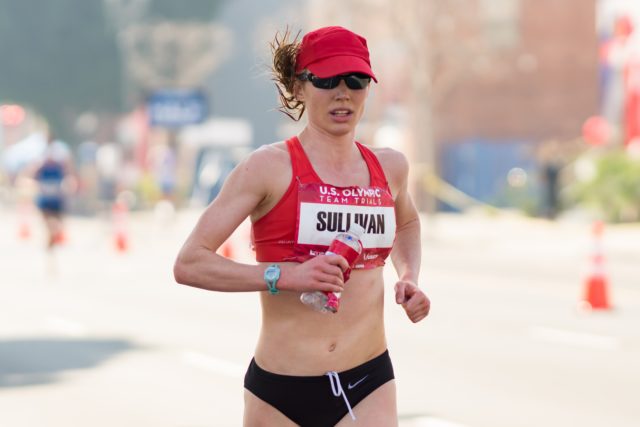
For the first 72 hours, Sullivan wasn’t even excited. She was just relieved.
“Someone told me I probably hadn’t run that many 6:15s combined until I averaged that in Richmond,” she said. “It was ugly, but I got what I needed out of it.”
She got three more months our of the slowest of her four marathons.
Sullivan took a week off after Richmond, then eased back in for another week. As December kicked off, she went on her first run without taking her phone along in case she needed a rescue.
“Every run since Richmond has felt great,” she said. “Whatever I had going in, it’s still there.”
For the first time in more than two years, she’s making plans again, toying with a training trip to California, but also looking forward to training in Virginia and D.C., where she hopes to find the hills that will prepare her for the course in Atlanta. She visited the city during the summer but didn’t run parts of the course.
Sullivan likes to plan ahead, but, like stepping on the Trials course before she qualified, she didn’t make hotel or flight reservations until after Richmond.
“That was a lot of fun for me, like a reward to be able to make those reservations,” she said.
Then there’s the matter of planning out her next three months.
“I’ll do everything I can to be the fittest I can be going into a marathon,” she said. “I feel like I’m stronger than I’ve ever been, and I’m a lot more mature about training now.
“I’m less anxious about every day. I’m a little more willing to look at the big picture instead of each day being a success or failure.”
That should bode well for her working relationship with Buckheit, who is also eyeing the task ahead.
“If she wants to be top 20 again, she’s going to have to change some things,” he said, namely easing up the pace of her distance runs.
“I want to try to come to some happy medium. I want to get her to slow down, get back to the formula that worked so well for her four years ago.”
He’d also like to see her get back on the track, but that’s contingent on those easy-paced runs in between the workouts
“When she has the turnover, everything is easier,” he said. “Once you can run a fast 5k, everything slower feels like jogging.”
She may run the Houston Half Marathon in January as a tuneup, but without designs on her 1:12:56 PR from a month before the 2016 Trials.
“I’d obviously like to be setting PRs left and right, but I’m excited to do this now,” Sullivan said. “As frustrating as the last two years have been, I’d rather be in this place now, feeling fresh and excited about training. I love seeing the progress kids make in class, and I’m in a position now where I can see my own progress the next few months.”
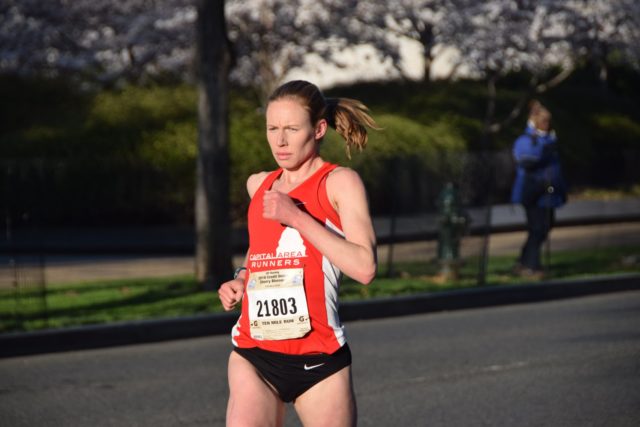
Recent Stories
Looking for our race calendar? Click here Submit races here or shop local for running gear
James W. Foley Freedom Run
Inspired by the moral courage of freelance journalist James Foley, the mission of the nonprofit Foley Foundation is to secure the freedom of Americans held captive abroad unjustly by terrorist organizations or rogue states, and to promote journalist safety.
The
Kensington 8K Race
Since 1994, the Kensington 8K Race has been a favorite DC area fall race – a fun, fast event with beauty, challenge, and excitement. Run it this year on Saturday, September 21, 2024!
The 8K distance is $39, with a


